Lado Kranjčević
Computationally Efficient Optimisation of Elbow-Type Draft Tube Using Neural Network Surrogates
Jan 14, 2024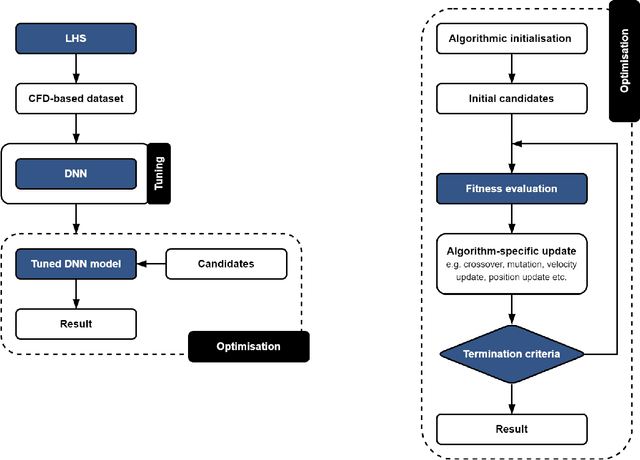

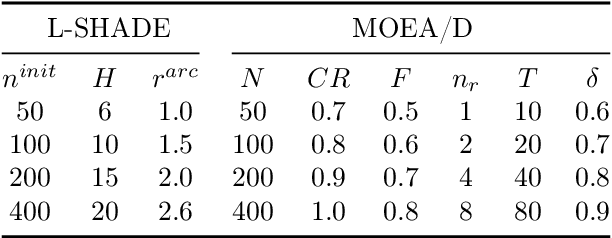
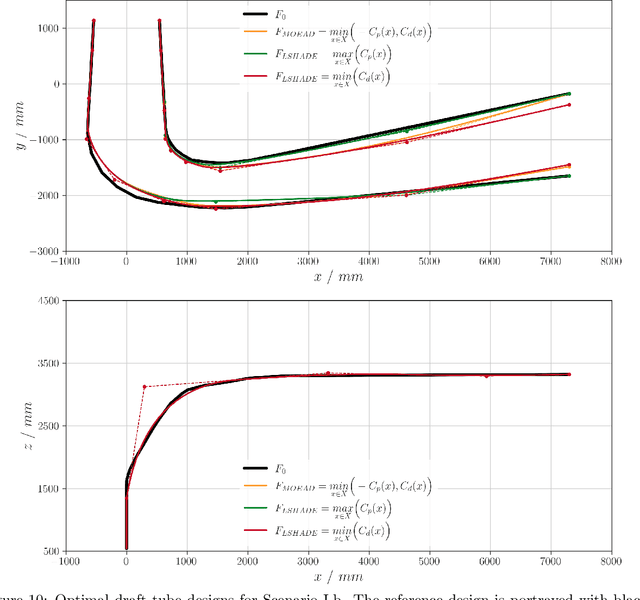
Abstract:This study aims to provide a comprehensive assessment of single-objective and multi-objective optimisation algorithms for the design of an elbow-type draft tube, as well as to introduce a computationally efficient optimisation workflow. The proposed workflow leverages deep neural network surrogates trained on data obtained from numerical simulations. The use of surrogates allows for a more flexible and faster evaluation of novel designs. The success history-based adaptive differential evolution with linear reduction and the multi-objective evolutionary algorithm based on decomposition were identified as the best-performing algorithms and used to determine the influence of different objectives in the single-objective optimisation and their combined impact on the draft tube design in the multi-objective optimisation. The results for the single-objective algorithm are consistent with those of the multi-objective algorithm when the objectives are considered separately. Multi-objective approach, however, should typically be chosen, especially for computationally inexpensive surrogates. A multi-criteria decision analysis method was used to obtain optimal multi-objective results, showing an improvement of 1.5% and 17% for the pressure recovery factor and drag coefficient, respectively. The difference between the predictions and the numerical results is less than 0.5% for the pressure recovery factor and 3% for the drag coefficient. As the demand for renewable energy continues to increase, the relevance of data-driven optimisation workflows, as discussed in this study, will become increasingly important, especially in the context of global sustainability efforts.
Reconstruction and analysis of negatively buoyant jets with interpretable machine learning
Nov 10, 2022Abstract:In this paper, negatively inclined buoyant jets, which appear during the discharge of wastewater from processes such as desalination, are observed. To minimize harmful effects and assess environmental impact, a detailed numerical investigation is necessary. The selection of appropriate geometry and working conditions for minimizing such effects often requires numerous experiments and numerical simulations. For this reason, the application of machine learning models is proposed. Several models including Support Vector Regression, Artificial Neural Networks, Random Forests, XGBoost, CatBoost and LightGBM were trained. The dataset was built with numerous OpenFOAM simulations, which were validated by experimental data from previous research. The best prediction was obtained by Artificial Neural Network with an average of R2 0.98 and RMSE 0.28. In order to understand the working of the machine learning model and the influence of all parameters on the geometrical characteristics of inclined buoyant jets, the SHAP feature interpretation method was used.
Machine learning based surrogate models for microchannel heat sink optimization
Aug 20, 2022



Abstract:In this paper, microchannel designs with secondary channels and with ribs are investigated using computational fluid dynamics and are coupled with a multi-objective optimization algorithm to determine and propose optimal solutions based on observed thermal resistance and pumping power. A workflow that combines Latin hypercube sampling, machine learning-based surrogate modeling and multi-objective optimization is proposed. Random forests, gradient boosting algorithms and neural networks were considered during the search for the best surrogate. We demonstrated that tuned neural networks can make accurate predictions and be used to create an acceptable surrogate model. Optimized solutions show a negligible difference in overall performance when compared to the conventional optimization approach. Additionally, solutions are calculated in one-fifth of the original time. Generated designs attain temperatures that are lower by more than 10% under the same pressure limits as a convectional microchannel design. When limited by temperature, pressure drops are reduced by more than 25%. Finally, the influence of each design variable on the thermal resistance and pumping power was investigated by employing the SHapley Additive exPlanations technique. Overall, we have demonstrated that the proposed framework has merit and can be used as a viable methodology in microchannel heat sink design optimization.
Predictive modeling of microbiological seawater quality classification in karst region using cascade model
Feb 11, 2022Abstract:In this paper, an in-depth analysis of Escherichia coli seawater measurements during the bathing season in the city of Rijeka, Croatia was conducted. Submerged sources of groundwater were observed at several measurement locations which could be the cause for increased E. coli values. This specificity of karst terrain is usually not considered during the monitoring process, thus a novel measurement methodology is proposed. A cascade machine learning model is used to predict coastal water quality based on meteorological data, which improves the level of accuracy due to data imbalance resulting from rare occurrences of measurements with reduced water quality. Currently, the cascade model is employed as a filter method, where measurements not classified as excellent quality need to be further analyzed. However, with improvements proposed in the paper, the cascade model could be ultimately used as a standalone method.
Coastal water quality prediction based on machine learning with feature interpretation and spatio-temporal analysis
Jul 09, 2021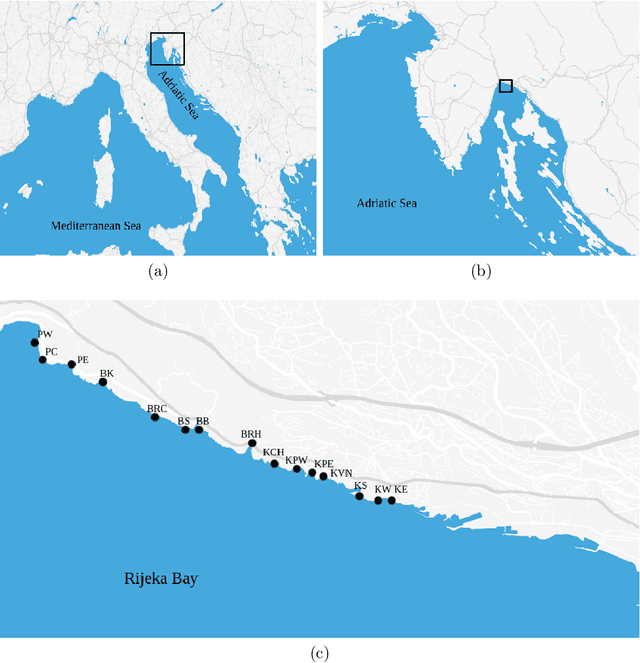

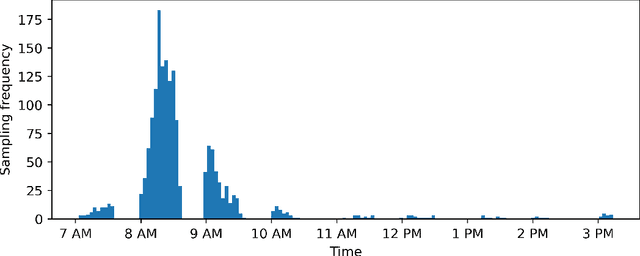
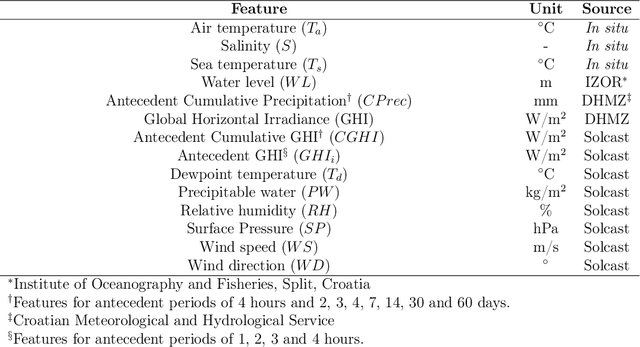
Abstract:Coastal water quality management is a public health concern, as poor coastal water quality can harbor pathogens that are dangerous to human health. Tourism-oriented countries need to actively monitor the condition of coastal water at tourist popular sites during the summer season. In this study, routine monitoring data of $Escherichia\ Coli$ and enterococci across 15 public beaches in the city of Rijeka, Croatia, were used to build machine learning models for predicting their levels based on environmental parameters as well as to investigate their relationships with environmental stressors. Gradient Boosting (Catboost, Xgboost), Random Forests, Support Vector Regression and Artificial Neural Networks were trained with measurements from all sampling sites and used to predict $E.\ Coli$ and enterococci values based on environmental features. The evaluation of stability and generalizability with 10-fold cross validation analysis of the machine learning models, showed that the Catboost algorithm performed best with R$^2$ values of 0.71 and 0.68 for predicting $E.\ Coli$ and enterococci, respectively, compared to other evaluated ML algorithms including Xgboost, Random Forests, Support Vector Regression and Artificial Neural Networks. We also use the SHapley Additive exPlanations technique to identify and interpret which features have the most predictive power. The results show that site salinity measured is the most important feature for forecasting both $E.\ Coli$ and enterococci levels. Finally, the spatial and temporal accuracy of both ML models were examined at sites with the lowest coastal water quality. The spatial $E. Coli$ and enterococci models achieved strong R$^2$ values of 0.85 and 0.83, while the temporal models achieved R$^2$ values of 0.74 and 0.67. The temporal model also achieved moderate R$^2$ values of 0.44 and 0.46 at a site with high coastal water quality.
 Add to Chrome
Add to Chrome Add to Firefox
Add to Firefox Add to Edge
Add to Edge